“Today I feel empowered, and we need to help other teachers feel empowered too,” Danbury teacher Luanelly Iglesias told fellow educators at CEA’s Summit on Diversity, a half-day event co-sponsored by CEA and NEA and hosted by CEA’s Racial and Ethnic Diversity Affairs Commission (REDAC).
Held in Rocky Hill on Saturday, April 29, the summit brought together dozens of underrepresented educators—mainly teachers of color—to connect and find strength in shared experiences. Westport literacy coach, NEA fellow, and CEA REDAC Chair Faith Sweeney said the summit was also aimed at creating a sense of belonging and elevating the voices of underrepresented members “so that decisions are made with our voices behind them.”
The morning opened with a panel discussion followed by a Q&A and personal reflections.

Faith Sweeney and Sandra Peterkin welcome educators to CEA’s Summit on Diversity.
‘The only’
Panelist Gail Jorden, a fifth- and sixth-grade teacher and the president of the Bloomfield Education Association, recalled being the only student of color in her classes growing up. Because of that, she said, was frequently asked for her perspective.
Being expected to represent an entire demographic has its issues, but for Jorden it also created a natural path to leadership. After ten years of operating in what she called “survival mode” in the classroom, she decided to step into a leadership role as a union building rep, then grievance chair, followed by local union president.
“When you face all those glass ceilings, walls, and cliffs, believe in yourself,” she said, adding, “Reflect on your decisions, the outcomes, and what you can do better.”
“You are the change you desire,” REDAC Director at Large Sandra Peterkin emphasized.
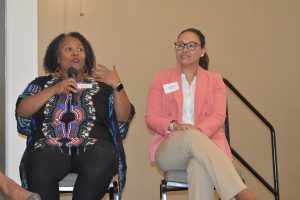
Panelists Gail Jorden and Sam Rosenberg speak to teachers of color often being ‘the only’ in their school.
Stepping up
Joining Jorden on the panel were Michael Gordon, building representative, equity and inclusion instructional leader, and music instruction leader for fine and performing arts at Wilton Public Schools; Hamden teacher and legislative council member Katie Kiely; Dr. Tonya Claiborne, director of diversity, equity, and inclusion at Glastonbury Public Schools; Cheshire Public Schools administrator, board of education member, and former CEA board member Sam Rosenberg; Westport high school principal Stafford Thomas; Kevin Walton, ACES senior director of equity and inclusion; and Dr. Lara White, director of equity and inclusion for Waterbury Public Schools; and Stamford Superintendent Dr. Tamu Lucero.
“My leadership journey began at the middle school where I teach,” said Gordon. “I was one of only two Black teachers. There were custodians and paraeducators, but no teachers of color. My administrator pointed out, ‘You are a Black face in a white space, and it’s necessary for you to be a leader in that space—not just for the three or four students of color here at our school but for all the white children who need to see a person of color as a leader.’”
Gordon’s advice to other educators of color? “Make your space. As a person of color coming up through my district, being mentored, and seeing how things work on the back end, I realized the importance of stepping up and saying, ‘I am the person you need for this position, and here’s why.’ It may not always be well-received, but others will have to wrestle with that.”
Walton added, “I’ve always been in spaces where I’ve been the only person of color. Be courageous about amplifying your voice—especially when you’re the only one.”
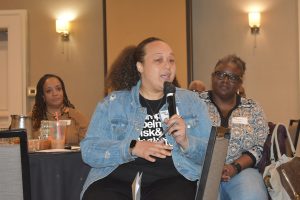
Windsor teacher Laina Rivers asks panelists a question.
Speaking up
“I’ve been the ‘only’ in many places too, and imposter syndrome and gaslighting are real and rooted deep,” Claiborne agreed. “What positioned me to become a leader is always asking questions. It’s not about having all the answers but about asking the right questions. If you’re not getting satisfactory answers, find them yourself. You’re in the classroom. You’re changing lives. You’re leading. Remember, other people doing this work aren’t smarter than you, and they don’t know more than you. They are in positions of access. If a door is closed to you, kick it down.”
For Kiely, asking questions and speaking up have been critical as well.
“You can’t be a leader if you’re not also learning,” she said. “Avoid groupthink. Even if you’re ‘the only,’ you’re not alone. Make sure your inner voice is the loudest.”
As a teacher who serves in local government, Kiely says, “Being in the political arena, I can be the one who gives those who are underrepresented the extra two minutes to speak or the one who calls on people to share.”
Rosenberg, an educator also active in local politics, said, “As a person of color, as an Asian educator, I found little representation; we gravitate toward each other because of our shared experiences. I have multiracial children, so it’s important for me to find those same connections for them. My advice for fellow educators of color who want to lead in any arena is this: Persist, persevere, give yourself grace when you are defeated, and get back out there, because we need you. When I first ran for office, I lost. My husband said, ‘Put your face out there and put your picture on your campaign flyers.’ The second time around I did that, and I won. I’m the only person of color on my board, and before I leave the board, we are going to have an equity policy, and it’s not going to sit on the shelf.”
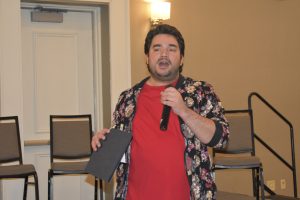
CREC EDEC Chair Theo Martinez shares his experiences as an underrepresented educator.
Who, if not you?
Thomas, who started his career as a teacher before becoming an administrator—and whose mother taught for 50 years—noted, “We don’t see many applicants of color for administrator positions. Connecticut is racially isolated, and many people of color question, ‘Do I really want to be the only one?’ And I understand that, because you will not be given the benefit of the doubt, and you will need to be more prepared. But know the influence you can have. I ask, ‘Who, if not you?’”
“When you have those moments of doubt or defeat, understand that you are valuable and your voice does matter,” said White. “Be the person you always needed.”
Many panelists reflected on the lack of opportunities for students of color and white children to learn alongside each other in a country that is still largely segregated.
“I come from a multiracial family,” said Kiely, “and as a child, I went to seven different elementary schools, from Los Angeles to Litchfield to Boston. I found myself in urban and rural educational environments. I attended a very wealthy high school, but I also experienced homelessness and lived in a homeless shelter. Despite all these experiences, as a student I was never in diverse settings. Schools were either predominantly Black or predominantly white. And that’s how it remains.”
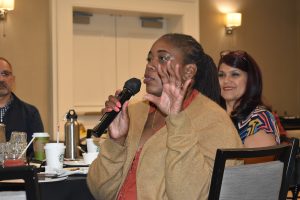
Stamford educator Tricia Conduah addresses the panel.
White pointed out that 52% of children in Connecticut are Black, indigenous, or people of color. “It’s not about minorities, but about segregation.”
In addition to segregation, children of color also face a lack of representation among their teachers and administrators.
“I never had a Black teacher until I went for my master’s degree,” one educator shared with the panel. “I don’t want another child to have that experience.”
Further, Locero pointed out that in a field where 78% of educators are women, only one in five superintendents are.
“If you aren’t doing your research about biases against women and institutional racism,” she said, “read and understand, or you will start to question yourself; you will duck and cover. When you don’t have a seat at the table, or you have a fake seat at the table, when you are ‘the one,’ your voice needs to be stronger.”
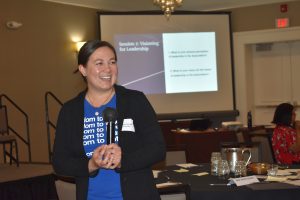
Glastonbury Education Association President Kristen Basiaga is a member of CEA’s Ethnically Diverse Educators Commission.
“Don’t be afraid to ask questions and have conversations,” White added. “That’s how EMAC—the Ethnic Minority Affairs Commission—changed its name to REDAC.”
10 tips for empowering yourself, others
EDEC leaders and panelists shared various advice for underrepresented educators to find each other, find their voice, and become leaders in their communities.
- Show your face. Make connections. Start by participating in CEA meetings, training opportunities, and other events. Attend CEA county forums so that you know what’s going on in local associations near you.
- Find a mentor. Not sure where to look? See above.
- Be a mentor. In particular, consider becoming a TEAM mentor so that other educators benefit from your perspective and experience.
- Reach out. Look out for others who are underrepresented and lift them up.
- Speak up. What are you passionate about? Share your ideas with colleagues, administrators, and central office.
- Take the lead on legislation. Think about what’s needed, for example, to recruit and retain more teachers of color. Is it affordable housing? Is it changes to teacher preparation? “Who’s to say you’re not to lead that effort?” Sweeney points out. “You see the need; you feel the need.”
- Start a future educators club at your high school. Influence your students. Make sure they see the positives about our profession.
- Volunteer to be a building rep at your school.
- Join a CEA committee that interests you. Here’ a list.
- Influence decisions at the local or state level by running for office. NEA’s “See Educators Run” provides training and support.


